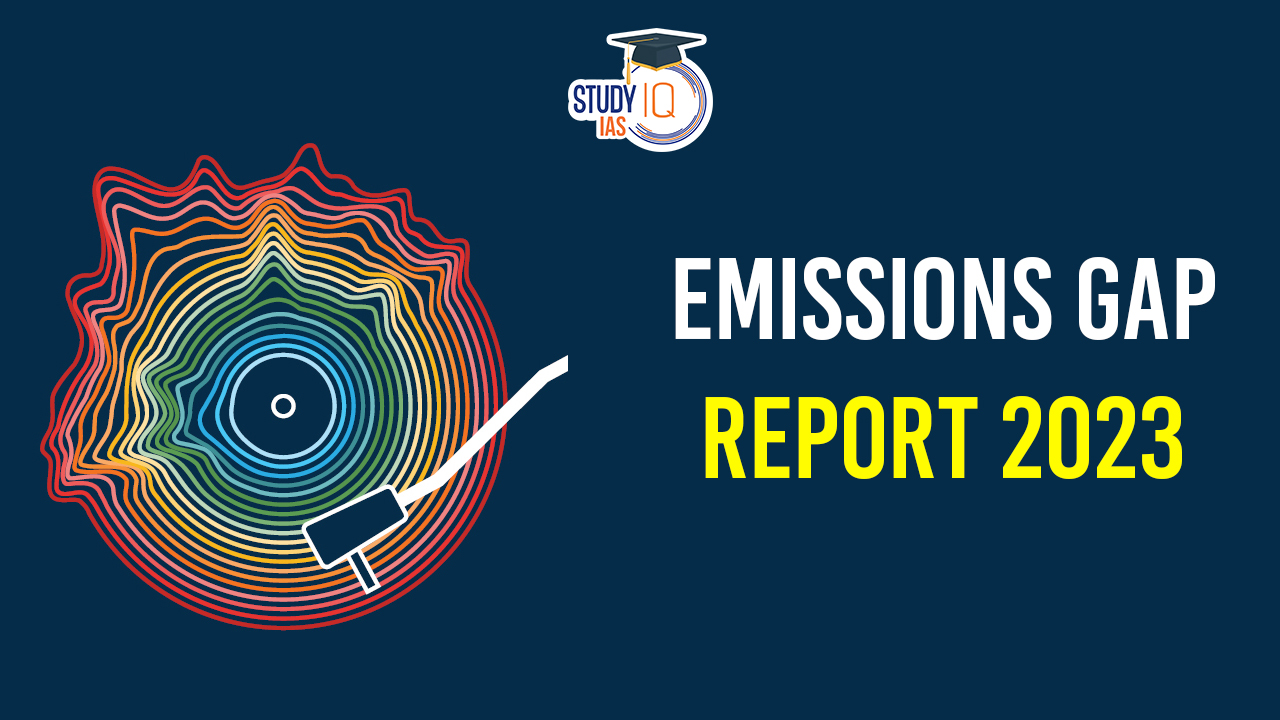Table of Contents
Context: The United Nations Environment Programme (UNEP) released the 14th Emissions Gap Report 2023 titled “Broken Record – Temperatures hit new highs”.
About Emission Gap Report 2023
- Emission gap: It is the difference between where greenhouse gas emissions are projected to be in 2030 and where they should be to limit global warming to well below 2°C or 1.5°C.
- Report: It is an annual assessment that evaluates the gap between the amount of global greenhouse gas emissions now and what is necessary to meet the objectives of the Paris Agreement.
Key Highlights of Emission Gap Report 2023
Rising Temperatures in 2022
- Temperature Surge: In 2022, there were 86 days exceeding the 1.5-degree Celsius mark, linked to a record rise in global greenhouse gas emissions.
Post-Paris Agreement Progress
- Emission Reductions: Since the 2015 Paris Agreement, projected greenhouse gas emissions for 2030 have decreased from an anticipated rise of 16% to 3%.
- Targets for the Paris Agreement: To align with the Agreement’s goals, 2030 emissions need to drop 28% for the 2°C pathway and 42% for the 1.5°C pathway.
Emission Inequality
- Country Contribution: The USA, with 4% of the global population, contributed 17% to global warming from 1850-2021, while India, with 18% of the population, contributed 5%.
- Income Disparity in Emissions: The top 10% of income earners, mainly from developed countries, are responsible for 48% of emissions, whereas the bottom 50% contribute only 12%.
Carbon Dioxide Emissions
- Record Levels: Global GHG emissions rose by 1.2% from 2021 to 2022, reaching a new high of 57.4 gigatons of CO2 equivalent (GtCO2e)
Emissions of Major Contributors
- Varied Trends: Emissions increased in 2022 for major emitters like China, the USA, and India, while the EU, Russia, and Brazil saw decreases.
COVID-19 Impact
- Limited Reduction: The pandemic-induced slowdown in 2020 led to only a 4.7% decrease in emissions from 2019.
Consequences of Inaction
- Heat Records: 2023 is on track to be the hottest year, surpassing 2016.
- Monthly Records: Each month of the year is setting new temperature records, with September being the hottest ever.
- Future Projections: The World Meteorological Organisation predicts that one of the next four years will likely exceed the 1.5-degree Celsius annual average threshold.
Measures Required to Overcome the Challenges of Emission Gap Report
- Pledges by signatories: Among G20 members, 19 members have committed to achieving net-zero emissions, up from 17 at COP 26. However, many countries need to further refine their NDC pledges to be on the path to achieving climate goals.
- Systematic transformation: Transformations are required in the sectors of electricity supply, industry, transport and buildings. There is a need to apply zero-emissions technologies and promote behavioural change to sustain and deepen efforts to reach zero emissions.
- Transforming food systems: Food systems contribute to climate change, apart from land-use change, depletion of freshwater, and pollution of ecosystems. Required changes include shifting diets, protecting natural ecosystems, improving food production and decarbonizing the food value chain.
India’s Pledges Under NDCs for Emission Gap
- Emission intensity: Emissions intensity is defined as the total amount of emissions emitted for every unit of GDP.
- India has pledged to reduce the emissions intensity of the GDP by 45% by 2030, compared to the 2005 level. The goal to reduce emissions intensity and improve energy efficiency is not sector-specific.
- India aims to work towards improving the emissions intensity of its GDP by 33-35% below the 2005 level by 2030.
- Current status: In 2020, India has claimed to have already achieved 21% of its emissions intensity as a proportion of its GDP in line with its commitment.
- Share of non-fossil-based energy: India has planned to achieve about 50% of cumulative electric power installed capacity from non-fossil fuel-based energy resources by 2030.
- India plans to use low-cost international finance, including the Green Climate Fund (GCF), to achieve this objective.
- Sustainable living: India will promote sustainable living based on traditions, conservation, and moderation to combat climate change.
- LiFE: It has initiated a mass movement for “LiFE” – lifestyle for environment. LiFE is a public movement that encourages people to become pro-planet.
- Other pledges
- Adopting a cleaner path for economic development
- Creating additional carbon sinks of 5 to 3 billion tonnes of CO2 equivalent through additional forest and tree cover.
- Adapting to climate change by improving investments in development programmes in vulnerable sectors
- Mobilizing funds from developed countries for implementing better mitigation and adaptation actions
- Building architectural framework for quick solution and better research and development for climate technologies
Emissions Gap Report: Paris Agreement 2015
- The 2015 Paris Agreement is a legally binding international climate treaty, adopted by world leaders attending the Climate Conference, COP21.
- The treaty was adopted by 196 countries on December 12, 2015, and came into force on November 4, 2016.
- Goal: The main objective of the agreement is to keep average global temperatures “well below two, preferably to 1.5 degrees Celsius”, compared with pre-industrial levels.
Emissions Gap Report and UNEP
- UNEP is a global authority responsible for handling environmental issues within the United Nations system.
- Its mandate includes providing leadership, delivering science and developing solutions on a wide range of issues such as climate change, the management of marine and terrestrial ecosystems, and green economic development.
- The major aim of UNEP is to help the world meet the 17 Sustainable Development Goals.


 Daily Quiz 01 July 2025
Daily Quiz 01 July 2025
 Special Intensive Revision (SIR) of Elec...
Special Intensive Revision (SIR) of Elec...
 National Doctor’s Day 2025: History, T...
National Doctor’s Day 2025: History, T...





















